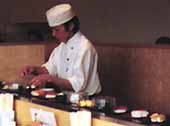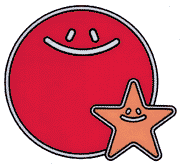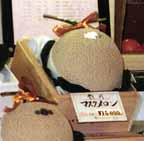More Observations (and some conclusions)
Ten General Observations
- I once heard the rhetorical question, "What did the
Japanese do before cameras?" In the great scheme of things,
I'd rephrase that as "What did the Japanese do before
paper?" but after this trip it would have to be "What did
the Japanese do before Cell-Phones?" They've all got 'em,
and they're all using them - if not as speaking instruments,
then they're scrutinizing the little LCD panels at the
top of these candy-bar-sized units - I guess they
double as pagers, and messages are readable there. A
very few were observed with that illuminated-antenna-tip
accessory: an LED which lights up when the phone's in use.
- The platform shoe
is big among certain young women. This
 look - the micro-skirt, bleached chapatsu hair, and
boots with ridiculously thick soles - says "hooker" to me,
but you see a lot of it on the streets of Tokyo. Rarely,
the skirt, perhaps of leather, has a fringe; and a little
cowboy hat completes the ensemble, creating a ridiculous,
hopelessly inauthentic faux-Western look.
look - the micro-skirt, bleached chapatsu hair, and
boots with ridiculously thick soles - says "hooker" to me,
but you see a lot of it on the streets of Tokyo. Rarely,
the skirt, perhaps of leather, has a fringe; and a little
cowboy hat completes the ensemble, creating a ridiculous,
hopelessly inauthentic faux-Western look.
- The approaching holiday season - although not as obvious as
my third trip, in December 1992, I did see some evidence.
Thankfully, the Japanese continue with their indifference
to Halloween (the reason I schedule overseas vacations at
the end of October is to avoid this day) although a few
attempts to "celebrate" it were observed in American-based
multinational chains (like the Halloween pastry available
at Mr. Donut). Saw a few Santas, the most amusing being one
of the usual Colonel Sanders statues (off-site
photo)
out front of a Kentucky Fried, this particular Colonel dressed
in a red Santa suit. A variation was observed in this year's
atrocious Christmas gadget-decoration - the "dancing Santa"
(check any card/gift shop if you haven't been exposed yet).
Once, I saw an Old West-fascist variant - instead of white,
his red suit was trimmed in black, and he was sporting a
black cowboy hat.
- Scooters - not the motorized kind. Of course,
bicycles are the dominant form of self-propelled
transportation; but unlike in the US, skateboards were
very rare and rollerblade skates completely unseen.
Sights of little scooters were not uncommon, however;
and some were very interesting. They always seemed to
be entirely composed of shiny chrome metal, and the
handlebar pole on the smaller units seemed to be
collapsable, so the thing could be folded up into a
small size for subway carry-on. The bigger ones
looked like they had brakes, with bicycle-style
brake-levers on their handlebars - this vehicle
was appealing and made enormous sense to me, and if
I was in an urban situation where I had to commute on
foot, I would've brought one home (like this
(Viza).
- Revolving kaiten sushi bars:
Industrial-delivery sushi, served on little dishes which
the hungry diner removes as desired from a conveyor belt
circling around the sushi chefs. The customers sit
on a counter surrounding the conveyor belt, and usually
a legend is mounted on the wall, indicating the different
prices (although sometimes this info appears on
specially-labeled dishes rotating
 around on the belt). You take what looks good, each
saucer holding one order, and you stack up the color-coded
empties as you eat. When finished, stand up and approach
the cash register; by the time you get there one of the
staff will have talleyed your quantities and shouted the
figure up front. They're great because one can enter the
restaurant and be eating within moments, although
some people are a bit leary because certain
items could've been sitting there for hours, rotating;
but you can always ask the guy for what you want if
fresh is desired. I call these places "mechanical sushi
bars." (More sushi questions? You might try this
sushi reference.)
around on the belt). You take what looks good, each
saucer holding one order, and you stack up the color-coded
empties as you eat. When finished, stand up and approach
the cash register; by the time you get there one of the
staff will have talleyed your quantities and shouted the
figure up front. They're great because one can enter the
restaurant and be eating within moments, although
some people are a bit leary because certain
items could've been sitting there for hours, rotating;
but you can always ask the guy for what you want if
fresh is desired. I call these places "mechanical sushi
bars." (More sushi questions? You might try this
sushi reference.)
- The Blue LED is phasing into use. (Read about its
invention (in Japan) in
this
old Wired article.) The marquee arrays
of LEDs are very common form of signage in Japan, but it
was the rare model indeed I saw which had blue LEDs in
its array (orange is the low-end default color). Not to
say they weren't everywhere, they were, on many of these
marquee signs, but as attention-grabbing pinpoints
flashing in RGB triplets around the array's
perimeter. I quess they're still relatively expensive,
in contrast to their red and green brothers.
- Konbini
(convenience stores):
Seems like there's way more of these than when I was
last in Japan, in 1992. I
don't recall noticing much of a presence by our
domestic chains of C-Stores 1
back then; now, the 7-11 is common and
AM-PM Mini Market is everywhere.
2
 A chain I recall from my earlier Japan trips was
still in business, the Family Mart - this time I was
able to snag a copy of their jolly logo, mascots - whatever
it is, they don't get very prominant display anymore. Other
common chains were the Mini-Shop, the ubiquitous
A chain I recall from my earlier Japan trips was
still in business, the Family Mart - this time I was
able to snag a copy of their jolly logo, mascots - whatever
it is, they don't get very prominant display anymore. Other
common chains were the Mini-Shop, the ubiquitous
 Lawson's (Station), Sunkus
(with its suggestive walking "K" logo), and many
others with unfamiliar, difficult-to-remember names;
although their stock all seemed pretty uniform (and
unlike their stateside counterparts, fascinating to
peruse). I loved the steam buns, sold from little
glass-walled warming-cabinets up on the counter near
the cash register - these buns were a little
smaller than those I've had in dim sum parlors,
and they had proportionatly more filling and weren't
nearly as doughy. Wasn't just a price read-out facing
the customers, on the cash register at the 7-11s;
rather, a big laptop-style screen flashing full-color
advertisements between transactions. Supermarkets in
California are moving in this direction, but not there
yet; so far their smaller, satellite screens are just
showing text describing the items as they're rung up.
However, my bank's ATMs now show animated color ads
while idle, O Brave New World.
Lawson's (Station), Sunkus
(with its suggestive walking "K" logo), and many
others with unfamiliar, difficult-to-remember names;
although their stock all seemed pretty uniform (and
unlike their stateside counterparts, fascinating to
peruse). I loved the steam buns, sold from little
glass-walled warming-cabinets up on the counter near
the cash register - these buns were a little
smaller than those I've had in dim sum parlors,
and they had proportionatly more filling and weren't
nearly as doughy. Wasn't just a price read-out facing
the customers, on the cash register at the 7-11s;
rather, a big laptop-style screen flashing full-color
advertisements between transactions. Supermarkets in
California are moving in this direction, but not there
yet; so far their smaller, satellite screens are just
showing text describing the items as they're rung up.
However, my bank's ATMs now show animated color ads
while idle, O Brave New World.
- Choco: Bought some chocolate chip cookies at a
konbini one night; like a lot of sweet
foodstuffs sold in Japan the packaging went way
overboard: outer bag, inner plastic tray, and each
cookie individually sealed in its own foil envelope.
This particular line of cookies came in four flavors:
chocolate (what would be marketed here as
chocolate-chocolate chip), vanilla (what I had, seemed
like normal), "maron" (the picture indicated a mix of
both regular and [I guess] white chocolate chips) and
Earl Grey. This last choice was intriguing, in a
delayed-reaction way; but never available in
subsequent searches. Among the many
other interesting sweets I noticed, in the
adjacent aisle: "Crunky Popjoy" (in fact several
candy bars were labeled 'crunky') and
"Melty Kiss" candies.
- Food hall basements in the department stores - all
the guidebooks say free samples are so prevalent here
that you can practically replace the noon meal with a
foraging visit downstairs. My experience was, this is
no longer the case. I recall chunks of sashimi being
set out, with toothpicks for serving, when I first
visited Japan; now the few free samples I observed
were stingy. So much for the bubble economy.
If you do want to spend money, however, the $100
cantaloupes are still available:

- They're still smoking like fiends in Japan, where a
pack of cigarettes costs half the US price. But winds of
change are evident - now, for example, smokers are
restricted to certain zones of train platforms, like
the Off-Hours Waiting Areas in the New York City subway.
And there was no smoking on my trans-Pacific flight.
Conclusions - Summing Up
Only back a few days and I'm already morose about the
things I missed; so already contemplating the next
trip. A serious hindrance this time was health-related,
somehow I damaged my left knee about a month before
departure and this was a serious burden - the doctor
said it's not permanent damage, just a persistant
inflammation; still, coupled with the blisters raised
by those terrible shoes I was
really slowed down. Maybe this was a good thing, forcing
me to observe more details in my immediate vicinities,
and since I didn't quite attain all my goals, even better
in the long term since it'll provoke another return,
perhaps within the year.
Notes:
1 This is how they're designated
on freeway exit signs in the midwest.
Back
2 Seeing
those triggered memories of their advertising
jingle heard on LA radio circa 1981, set to the
tune of "Rock Around the Clock":
"You can shop
Around
The Clock Tonight
You can shop shop shop to your heart's delight" etc.
Say, what happened to the AM-PM in America? A
quick survey of local Arco stations turned up
very few - has their "C-Store"
participation withered?
Back
|



 A chain I recall from my earlier Japan trips was
still in business, the Family Mart - this time I was
able to snag a copy of their jolly logo, mascots - whatever
it is, they don't get very prominant display anymore. Other
common chains were the Mini-Shop, the ubiquitous
A chain I recall from my earlier Japan trips was
still in business, the Family Mart - this time I was
able to snag a copy of their jolly logo, mascots - whatever
it is, they don't get very prominant display anymore. Other
common chains were the Mini-Shop, the ubiquitous

